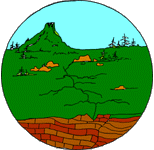|
|
1. Volcanoes can occur _________.
2. You are given a penny, a ball, and a glass. Which one of these objects would break if you stepped on it?
3. You are given several types of rocks from a volcano. How can you determine if they are different?
4. Plutonic rocks are made _________.
5. Volcanic rocks are cooled and formed _________.
6. Which type of rock will have large minerals?
7. Molten rock inside a volcano is called _________.
8. Volcanoes produce different types of rocks because of _________.
9. If a volcano erupts and the lava cools quickly the rocks that will be formed will probably have _________.
10. Scientists measure the energy produced by an earthquake by using a machine called a _________.
11. The outer surface of the Earth is called the _________.
12. Plate tectonics is _________.
13. An earthquake fault is due to _________.
14. Which of the following can cause damage during a volcanic eruption?
15. Volcanic eruptions can include _________.
ANSWERS: 1.(D); 2.(C); 3.(D); 4.(A); 5.(B); 6.(C); 7.(D); 8.(D); 9.(A); 10.(B); 11.(D); 12.(A); 13.(A); 14.(D); 15.(D) |

 Plate
Tectonic
Plate
Tectonic